3D printing offers a new format for access to graphics for students who are blind or have low vision. However, knowing where to start often is the hardest step in any new process. To help, this list highlights popular 3D printed models that you may like to request for printing at your school or through your accessible formats provider. In Australia, 3D printed materials are currently available by request from accessible formats production departments at NextSense, Braille and Large Print Services NSW, the Statewide Vision Resource Centre (SVRC) in Victoria, Education Queensland, South Australian School for Vision Impaired (SASVI), and BLENNZ.
See also the ANZAGG Guidelines on what to 3D print (and what not to print) and where to find 3D printing models for touch readers.
Braille and Communication
Braille Swing Cell
This model helps students to understand the relationship between the braille cell and the keys on a braille writer. In the closed position, the removable pegs inserted into the blocks represent the dots in a braille cell. In the open position, the pegs represent the keys on a brailler that correspond to each of the braille dots.
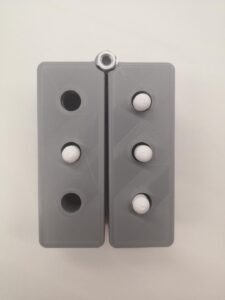
Approximate printing time: 3 hours
Source: Thingiverse thing 2704904
Braille Writer Finger Guide
This model slots in under the keys of a standard Perkins brailler to help keep fingers on the correct key.

Approximate print time: 6 hours
Printing tips: If your print bed is large enough, print the finger guide on its side for increased strength. If your print bed is too small, you may consider printing in two pieces.
Source: https://www.youmagine.com/designs/braille-writer-finger-guide
Universal Core Communication Pieces
3D symbols are available for the 36 words in the Universal Core vocabulary. Shape, texture, and colour are used to mark the word category, while a tactile symbol and braille are used to designate the word. The designers suggest starting by introducing the three key words “go”, “like” and “not”.

Approximate printing time: 1.5-2 hours per word
Source: https://www.project-core.com/3d-symbols/
Maths
Tactile Dice
Tactile dice are handy for counting, chance & date, and games.

Approximate printing time: Up to 30 minutes per dice
Sources: https://www.thingiverse.com/thing:2704808 for a six-sided dice with rounded dots; https://www.thingiverse.com/thing:2836494 for polyhedral dice with braille numbers
10 by 10 Cartesian Plane
A 10 by 10 grid with tactile markers along the axes and around each data point. Use it to plot points with push pins on top of a soft surface such as cardboard.

Approximate print time: 90 minutes
Source: https://medien.augenbit.de/3d-druck-modell-6/
Tactile Ruler
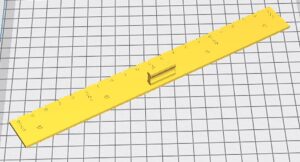
Approximate print time: Up to 3 hours
Printing tip: Note that many printers have a maximum size of around 20cm. Placing the ruler diagonally on the bed allows a rule of up to 25cm in length.
Source: A variety of rulers with measurements in cm are available from https://medien.augenbit.de/suchtreffer/?_sf_s=lineal
Protractor
This protractor has tactile markers and a movable arm. The tactile ticks mark every 5 degrees, with larger ticks every 30 and 45 degrees. The arm is secured with a screw that points upwards. Braille labels can be added after printing.
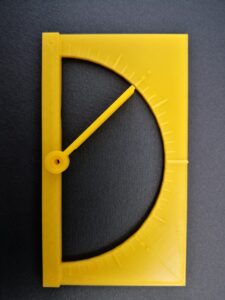
Approximate print time: Less than 2 hours
Source: https://www.thingiverse.com/thing:4420889 by SVRC
Chemistry
Atoms with Spinning Electron Shells
These atoms are printed in one piece but have spinning parts. The braille label gives the element symbol and atomic number (without a numeric indicator).
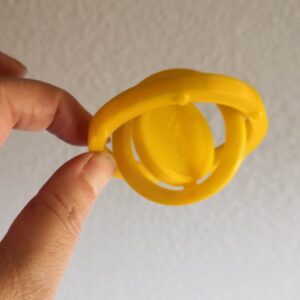
Approximate print time: 45 minutes for Hydrogen and Helium; 1.5 hours for Lithium to Neon; longer for larger atoms.
Source: https://www.thingiverse.com/thing:195834
Place and the Environment
Topographic Map
Customised topographic maps of any area that you choose. Mountainous regions work best. For example, you could print different types of mountains, iconic places such as Uluru or the Grand Canyon, nearby mountain ranges familiar to the student, or places of historic significance such as ANZAC Cove.
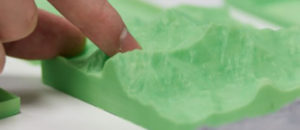
Printing time: Minimum 3 hours
Printing tips: A footprint of around 10×10cm is recommended. Reduce the height of the base for faster printing time and less waste.
Source: http://jthatch.com/Terrain2STL/
Water Cycle
Tiles to represent stages of the water cycle, with arrows for students to construct their own connections. The tiles have braille, print and tactile icons. Choose the tiles that are appropriate for your student’s level.

Approximate print time: 2 hours per tile
Printing tips: Print tiles standing on their side for smooth braille. A brim will assist with stability but needs to be removed with a craft knife to prevent sharp edges.
Source: https://www.thingiverse.com/thing:4692170
General Interest
Mars Rover
Curiosity is a car-sized robotic rover exploring Gale Crater on Mars. This 3D model, produced by NASA, has a manageable number of parts that can be constructed to create a moving vehicle.
Source: https://nasa3d.arc.nasa.gov/detail/mars-rover-curiosity
Sydney Opera House
Use this model to teach about Australian iconography, architecture, or how a tactile graphic shows only one side of a 3D object.

Source: https://www.thingiverse.com/thing:465989
Albert Einstein
Albert Einstein was one of the top 3 requests for tactile images of people in a recent survey by the National Federation of the Blind. This model includes a braille label.

Approximate print time: 6 hours at 10cm high
Printing tips: Support needed for the chin, moustache and nose
Source: https://www.thingiverse.com/thing:966908
thanks, very interesting 🙂